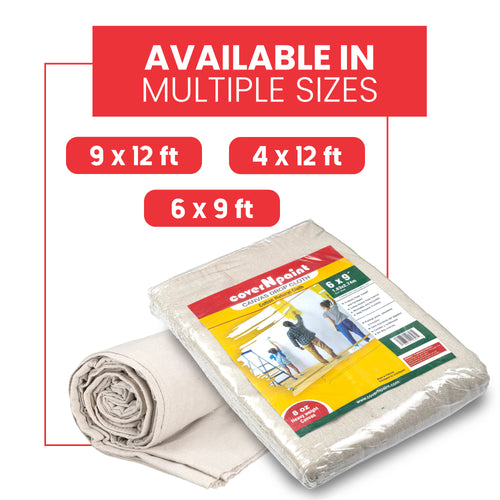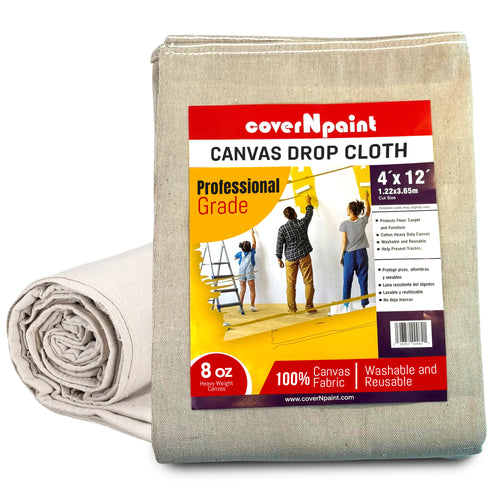When tackling home improvement or professional painting projects, safeguarding your floors is essential. One popular method for achieving this is using canvas drop cloths. These fabric coverings offer various benefits and considerations for floor protection.
Understanding Fabric Coverings
Fabric coverings used for floor protection are typically made from heavy-duty materials, including cotton and polyester blends. These materials are designed to withstand spills, paint splatters, and general wear and tear, making them a popular choice among homeowners and professionals alike.

Benefits of Fabric Coverings for Floor Protection
Durability:
High-quality fabric coverings are incredibly durable. They can handle the rigors of heavy foot traffic and are less likely to tear or rip compared to thinner alternatives. This durability makes them ideal for both short-term projects and long-term use.
Absorbency:
Fabric coverings have the advantage of being absorbent. This means they can soak up spills and splatters rather than allowing them to sit on the surface, which can be particularly useful when dealing with paint or cleaning products.
Non-Slip Surface:
Unlike some plastic options, fabric coverings provide a non-slip surface. This feature can help prevent accidents, especially in areas where spills are likely.
Eco-Friendly:
Fabric coverings are generally more environmentally friendly than plastic alternatives. They can be washed and reused, reducing the need for single-use products and minimizing waste.
Ease of Use:
Fabric coverings are often easier to handle and position than plastic sheeting. They are less likely to slide around or shift, making them easier to work with during projects.
Choosing the Right Fabric Covering
When selecting a fabric covering for floor protection, consider the following factors:

Material:
For optimal floor protection, choose high-quality, heavy-duty fabrics designed specifically for the task. Cotton and polyester blends are excellent choices due to their durability and absorbency. These materials offer robust defense against spills, stains, and general wear while providing a non-slip surface. Their resilience makes them ideal for both short-term projects and extended use, ensuring your floors remain safeguarded throughout the duration of your work.
Thickness:
Thicker fabrics offer enhanced protection against spills and impacts, making them ideal for high-traffic or messy projects. When selecting a fabric for floor protection, ensure it is sufficiently thick to withstand the demands of your task. A denser fabric will better absorb spills and provide more robust coverage, reducing the risk of damage to your floors. Investing in a high-quality, thick fabric can significantly improve your floor's protection and the longevity of the covering.
Size and Coverage:
When selecting a fabric covering for floor protection, it’s crucial to choose one that fits the entire area you need to protect. Measure your space carefully to ensure the fabric provides adequate coverage. Overlapping pieces can help cover larger areas, but make sure the entire surface is protected to prevent any damage. Proper sizing ensures that the fabric stays in place and offers effective protection throughout your project.
Ease of Handling:
When choosing a fabric for floor protection, consider its ease of handling and positioning. Fabrics that are excessively heavy or cumbersome can make the process of laying them down more challenging. Opting for a fabric that strikes a balance between durability and manageability will ensure smoother application and reduce the likelihood of frustration during your project. Easy-to-handle fabrics not only make the task simpler but also contribute to a more effective and efficient protection solution.
Care Instructions:
Before using a fabric covering for floor protection, check the care instructions carefully. Different fabrics may have specific cleaning requirements or need special detergents to maintain their quality. Following these guidelines will ensure the fabric remains effective and durable over time. Proper care helps prevent damage and prolongs the lifespan of your fabric covering, making it a more reliable option for safeguarding your floors.
Application Tips for Fabric Coverings
To maximize the effectiveness of fabric coverings for floor protection, follow these tips:
Prepare the Surface:
Before placing the fabric covering, make sure the floor surface is thoroughly clean and dry. This preparation ensures the fabric adheres properly and stays in place, maximizing its protective effectiveness. Removing any dust, dirt, or moisture will help prevent the fabric from shifting or bunching, providing better coverage and protection for your flooring throughout your project.
Secure the Edges:
To ensure your fabric covering stays in place, use painter’s tape or similar adhesive materials to secure the edges. This prevents the fabric from shifting or bunching up, which can compromise its protective function. Properly securing the edges helps maintain even coverage and prevents accidents or damage during your project. Be sure to press the tape down firmly to create a reliable barrier that holds the fabric in position.
Overlap and Layer:
When covering a large area, it’s important to overlap multiple pieces of fabric to ensure full coverage. This overlap prevents gaps that could allow spills or debris to reach the floor. By strategically layering the fabric, you enhance the protection and reduce the risk of damage. Ensure the edges are securely taped down to keep the fabric in place and maintain a continuous barrier against potential messes.
Regular Maintenance:
Check the fabric covering regularly for signs of wear or damage. Address any issues promptly to maintain effective floor protection.
Cleaning and Storage:
To ensure the longevity of your fabric floor covering, always follow the manufacturer's cleaning and storage instructions. Proper maintenance involves regular washing and careful handling to prevent damage. Store the fabric in a dry, cool place to avoid mold and deterioration. By adhering to these guidelines, you can keep your fabric covering in excellent condition and ready for reuse, providing effective floor protection for your future projects.
Floor Protection with Fabric Covers
Fabric coverings can indeed be used for floor protection, offering a range of benefits including durability, absorbency, and eco-friendliness. While they come with some drawbacks, such as cleaning challenges and cost, their overall effectiveness makes them a valuable tool for safeguarding your floors during various projects.













